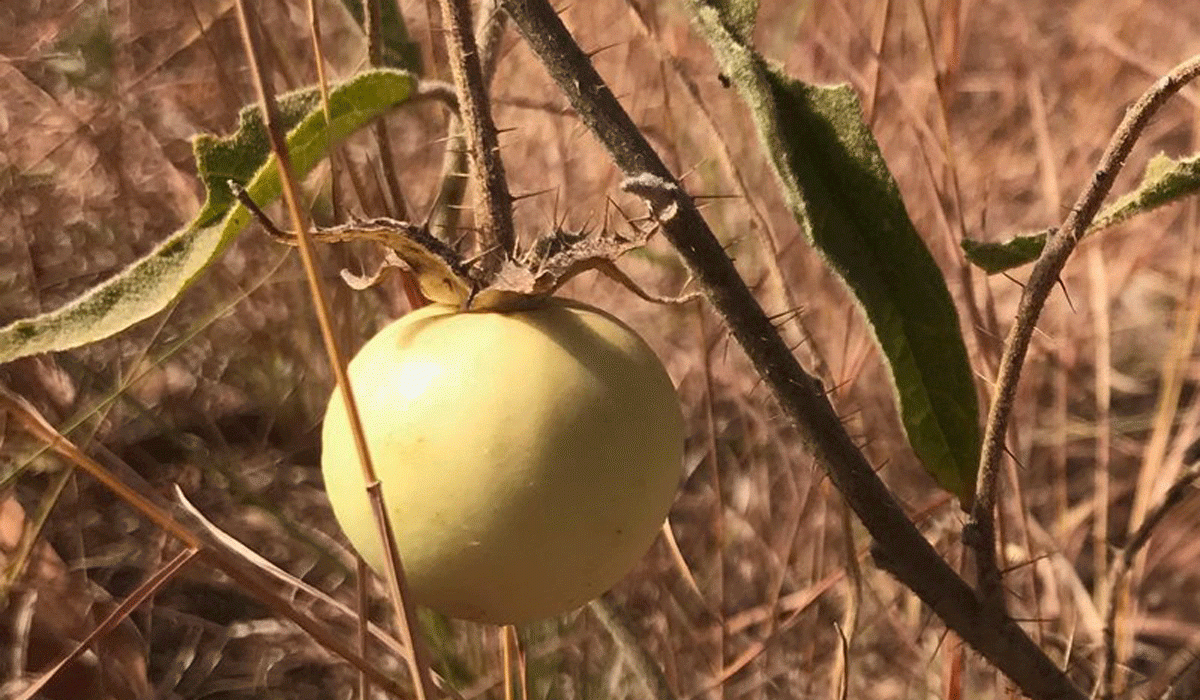Meet Australia’s sex-changing tomato: Solanum plastisexum

This humble bush tomato is challenging the "normative" sexual binary. Photo: Angela McDonnell
In the monsoon tropics of northern Australia, a little plant with prickles, grey-green leaves and purple flowers sprouted.
It did not have a name, and it confounded scientists: Every time they encountered the plant, the sex of its flowers had changed.
It is not unusual for plants to be hermaphrodites – that is, for their flowers to have both male and female reproductive functions – but this species, a bush tomato whose fertilised purple flowers produce cream-colour fruits, did not conform even to the fluid norms of the plant kingdom.
“This has me puzzled,” Peter Latz, a botanist from central Australia, wrote after a 1974 field trip in which he encountered the plant.
On Tuesday, some of the mysteries about this enigmatic species were revealed in a study published in open access journal PhytoKeys.
The researchers, from Australia and the US, say they hope the work will shed light on the diversity of sexual expression in the plant kingdom, as well as challenging the notion of “normative” sexual conditions for other living things.

The plant now known as Solanum plastisexum has puzzled scientists for decades. Photo: Angela McDonnell
The researchers have named the plant Solanum plastisexum, the second part of which is derived from a Greek root meaning “mouldable” or “changeable,” combined with the Latin word for sex. (As a common name, they suggest the Dungowan bush tomato, after the cattle station where the species was discovered).
“When considering the scope of life on Earth, the notion of a constant sexual binary consisting of distinct and disconnected forms is, fundamentally, a fallacy,” the researchers wrote.
Living organisms, including plants and animals, often exhibit diverse sexual forms, such as an all-female lizard species whose eggs have all the genetic material needed to reproduce, and clown fish, which are born male and can transform into females later in life.
Plants are especially fluid and might have flowers with only male or only female parts, or both, or reproductive systems that function differently from the way they appear.
In the genus Solanum, a member of the nightshade family that includes economically important crops such as tomatoes, eggplant, bell peppers and potatoes, such traits are especially common.
But even among them, Solanum plastisexum is unusual, the scientists say, because its sexual expression appears to be unpredictable, at least as far as they understand.
Angela McDonnell, a postdoctoral fellow in biology at Bucknell University in Pennsylvania and the lead author on the paper, said, “This particular new species has been unnamed for decades because no one has been able to understand what exactly it’s doing, and how it’s doing it, and why it’s doing it.
“It’s evaded classification.”
Christopher Martine, a professor of botany at Bucknell University who also worked on the paper, said, “Each time it was encountered, it was expressing itself a different way through its sexual form.”
Sometimes the plant’s flowers were hermaphrodite, at other times male and sometimes a mix of both, he said.
After first coming across the plant in 2016, the research team dug through the archives of the Northern Territory Herbarium at Palmerston, uncovering records of sightings during the 1970s. The scientists later collected seeds from central Australia and cultivated them in a chamber at Bucknell University designed to recreate the climate and light conditions of the Australian tropics.

“Each time it was encountered, it was expressing itself a different way through its sexual form,” one researcher said. Photo: Jason Cantley
By comparing the living plants with herbarium specimens and other previously collected data, the researchers said they were able to identify the Dungowan bush tomato as unique.
Australia is among a handful of countries considered to be megadiverse – meaning it has a vast range of plant and animal life – but about 70 per cent of the country’s species are undescribed, according to a 2009 government report.
“It’s exciting that there’s things in this world that have yet to be named,” McDonnell said. “We can’t conserve things that don’t have names.”
The threats of climate change and development mean that time is running out to document unidentified species before they disappear, many scientists say.
For now, McDonnell said, there was still work to be done in figuring out exactly why Solanum plastisexum exhibits its non-binary features.
She and her colleagues plan to use a DNA data set of the species to analyse its evolutionary history and try to better understand how and why the different sexual forms had evolved.
Martine said he hoped the team’s discovery could help shift the dial on conversations beyond his field.
“What we’re seeing in this one species is fairly unusual, but not unheard of,” he said.
“Plants really make an excellent example for what’s possible and what’s normal.”
-New York Times








